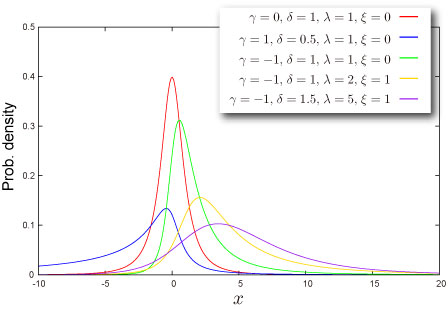Johnson SU Distribution
Where do you meet this distribution?
-
Finance, Economics : Value at Risk(VaR) model
"Estimation of Value at Risk Using Johnson Su-normal Distribution"
Shape of Distribution
Basic Properties
-
Four parameters are required (How can you get these).
-
Continuous distribution defined on entire range.
-
This distribution can be symmetric or asymmetric.
Probability
-
Cumulative distribution function
where
and ") is cumulative distribution function of standard normal distribution.
-
How to compute these on Excel.
| A | B | |
|---|---|---|
| 1 | Data | Description |
| 2 | 2.5 | Value for which you want the distribution |
| 3 | 1 | Value of parameter Gamma |
| 4 | 4 | Value of parameter Delta |
| 5 | 3 | Value of parameter Lambda |
| 6 | 0.9 | Value of parameter Xi |
| 7 | Formula | Description (Result) |
| 8 | =NTJOHNSONSUDIST(A2,A3,A4,A5,A6,TRUE) | Cumulative distribution function for the terms above |
| 9 | =NTJOHNSONSUDIST(A2,A3,A4,A5,A6,FALSE) | Probability density function for the terms above |

- Function reference : NTJOHNSONSUDIST
Quantile
-
Inverse of cumulative distribution function
where is cumulative distribution function of standard normal distribution.
-
How to compute this on Excel.
| A | B | |
|---|---|---|
| 1 | Data | Description |
| 2 | 0.5 | Probability associated with the Johnson SU distribution |
| 3 | 1 | Value of parameter Gamma |
| 4 | 4 | Value of parameter Delta |
| 5 | 3 | Value of parameter Lambda |
| 6 | 0.9 | Value of parameter Xi |
| 7 | Formula | Description (Result) |
| 8 | =NTJOHNSONSUINV(A2,A3,A4,A5,A6) | Inverse of the cumulative distribution function for the terms above |
- Function reference : NTJOHNSONSUINV
Characteristics
Mean -- Where is the "center" of the distribution? (Definition)
-
Mean of the distribution is given as
where
and is skewness of the distribution (see below)
-
How to compute this on Excel
| A | B | |
|---|---|---|
| 1 | Data | Description |
| 2 | 1 | Value of parameter Gamma |
| 3 | 4 | Value of parameter Delta |
| 4 | 3 | Value of parameter Lambda |
| 5 | 0.9 | Value of parameter Xi |
| 6 | Formula | Description (Result) |
| 7 | =NTJOHNSONSUMEAN(A2,A3,A4,A5) | Mean of the distribution for the terms above |
- Function reference : NTJOHNSONSUMEAN
Standard Deviation -- How wide does the distribution spread? (Definition)
-
Variance of the distribution is given as
where
Standard Deviation is a positive square root of Variance.
-
How to compute this on Excel
| A | B | |
|---|---|---|
| 1 | Data | Description |
| 2 | 1 | Value of parameter Gamma |
| 3 | 4 | Value of parameter Delta |
| 4 | 3 | Value of parameter Lambda |
| 5 | 0.9 | Value of parameter Xi |
| 6 | Formula | Description (Result) |
| 7 | =NTJOHNSONSUSTDEV(A2,A3,A4,A5) | Standard deviation of the distribution for the terms above |
- Function reference : NTJOHNSONSUSTDEV
Skewness -- Which side is the distribution distorted into? (Definition)
-
Skewness of the distribution is given as
where
-
How to compute this on Excel
| A | B | |
|---|---|---|
| 1 | Data | Description |
| 2 | 1 | Value of parameter Gamma |
| 3 | 4 | Value of parameter Delta |
| 4 | 3 | Value of parameter Lambda |
| 5 | 0.9 | Value of parameter Xi |
| 6 | Formula | Description (Result) |
| 7 | =NTJOHNSONSUSKEW(A2,A3,A4,A5) | Skewness of the distribution for the terms above |
- Function reference : NTJOHNSONSUSKEW
Kurtosis -- Sharp or Dull, consequently Fat Tail or Thin Tail (Definition)
-
Kurtosis of the distribution is given as
where
-
How to compute this on Excel
| A | B | |
|---|---|---|
| 1 | Data | Description |
| 2 | 1 | Value of parameter Gamma |
| 3 | 4 | Value of parameter Delta |
| 4 | 3 | Value of parameter Lambda |
| 5 | 0.9 | Value of parameter Xi |
| 6 | Formula | Description (Result) |
| 7 | =NTJOHNSONSUKURT(A2,A3,A4,A5) | Kurtosis of the distribution for the terms above |
- Function reference : NTJOHNSONSUKURT
Random Numbers
-
Random number x is generated by inverse function method, which is for uniform random U,
-
How to generate random numbers on Excel.
| A | B | |
|---|---|---|
| 1 | Data | Description |
| 2 | 100 | Number of random numbers to generate |
| 3 | 1 | Value of parameter Gamma |
| 4 | 4 | Value of parameter Delta |
| 5 | 3 | Value of parameter Lambda |
| 6 | 0.9 | Value of parameter Xi |
| 7 | Formula | Description (Result) |
| 8 | =NTRANDJOHNSONSU(100,A2,A3,A4,A5,0) | 100 Johnson SU deviates based on Mersenne-Twister algorithm for which the parameters above |
Note The formula in the example must be entered as an array formula. After copying the example to a blank worksheet, select the range A7:A106 starting with the formula cell. Press F2, and then press CTRL+SHIFT+ENTER.

NtRand Functions
- If you already have parameters of the distribution
- Generating random numbers based on Mersenne Twister algorithm: NTRANDJOHNSONSU
- Computing probability : NTJOHNSONSUDIST
- Computing quantile : NTJOHNSONSUINV
- Computing mean : NTJOHNSONSUMEAN
- Computing standard deviation : NTJOHNSONSUSTDEV
- Computing skewness : NTJOHNSONSUSKEW
- Computing kurtosis : NTJOHNSONSUKURT
- Computing moments above at once : NTJOHNSONSUMOM
- If you know mean and standard deviation of the distribution
- Estimating parameters of the distribution:NTJOHNSONSUPARAM